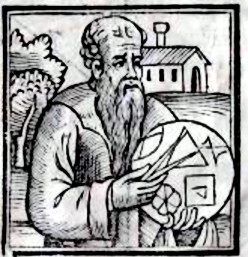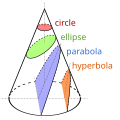Apollonius of Perga
Template:Thông tin nhân vật phong kiếnApollonius of Pergaeus (Ancient Greek: Ἀπολλώνιος, c. 262 BC – c 190 BC) was an ancient Greek astronomer and mathematician, well-known for his works related to conics . His innovative methods and terminology, especially in the field of conics, influenced many later scholars including Ptolemaeus, Francesco Maurolico, Johannes Kepler, Isaac Newton, and René Descartes. Apollonius gave the terms ofEllipse, Parabola, and Hyperbola as we use today. The hypothesis of eccentric orbits used to explain the apparent orbits of the planets and the rate of change of the Moon, or Apollonius's Theorem, was his discovery, later described by Ptolemaeus in volume XII.1 of Almagest. Apollonius also studied the Moon, a crater on the Moon that was named after him.
Apollonius | |
|---|---|
Ἀπολλώνιος | |
 Imaginary depiction of Apollonius from a 1537 edition of his works | |
| Born | c. 240 BC |
| Died | c. 190 BC |
| Known for | |
| Scientific career | |
| Fields | Geometry |
Apollonius Of Perga Media
The conic sections, or two-dimensional figures formed by the intersection of a plane with a cone at different angles. The theory of these figures was developed extensively by the ancient Greek mathematicians, surviving especially in works such as those of Apollonius of Perga. The conic sections pervade modern mathematics.
1661 edition of Conica by Apollonius edited by Giuseppe Cocchini
Reference
- Alhazen (1985). Hogendijk, J.P. (ed.). Ibn al-Haytham's Completion of the "Conics". New York: Springer Verlag.
- Apollonius. Apollonii Pergaei quae Graece exstant cum commentariis antiquis. Edited by I. L. Heiberg. 2 volumes. (Leipzig: Teubner, 1891/1893).
- Apollonius. Apollonius of Perga Conics Books I–III. Translated by R. Catesby Taliaferro. (Santa Fe: Green Lion Press, 1998).
- Apollonius. Apollonius of Perga Conics Book IV. Translated with introduction and notes by Michael N. Fried. (Santa Fe: Green Lion Press, 2002).
- Fried, Michael N.; Unguru, Sabetai (2001). Apollonius of Perga’s Conica: Text, Context, Subtext. Leiden: Brill.
- Knorr, W. R. (1986). Ancient Tradition of Geometric Problems. Cambridge, MA: Birkhauser Boston.
- Neugebauer, Otto (1975). A History of Ancient Mathematical Astronomy. New York: Springer-Verlag.
- Pappus of Alexandria (1986). Jones, A (ed.). Book 7 of the "Collection". New York: Springer-Verlag.
- Toomer, G.J. (1970). "Apollonius of Perga". Dictionary of Scientific Biography. Vol. 1. New York: Charles Scribner's Sons. pp. 179–193. ISBN 0-684-10114-9.
- Zeuthen, H. G. (1886). Die Lehre von den Kegelschnitten im Altertum. Copenhagen: Höst and Sohn.
- Text in Classical Greek: PDF scans of Heiberg's edition of the Conic Sections of Apollonius of Perga, now in the public domain
- In English translation: Treatise on the Conic Sections, trans. T.L. Heath
Other websites
- The Editors of Encyclopædia Britannica (2006). "Apollonius of Perga". Encyclopaedia Britannica.
- O'Connor, John J. "Apollonius of Perga". MacTutor History of Mathematics archive.
{{cite encyclopedia}}: Unknown parameter|coauthors=ignored (|author=suggested) (help) - David Dennis; Susan Addington (2009). "Apollonius and Conic Sections" (PDF). Mathematical Intentions. quadrivium.info.
- Scans of old editions of some of Apollonius' works in several languages at wilbourhall.org




